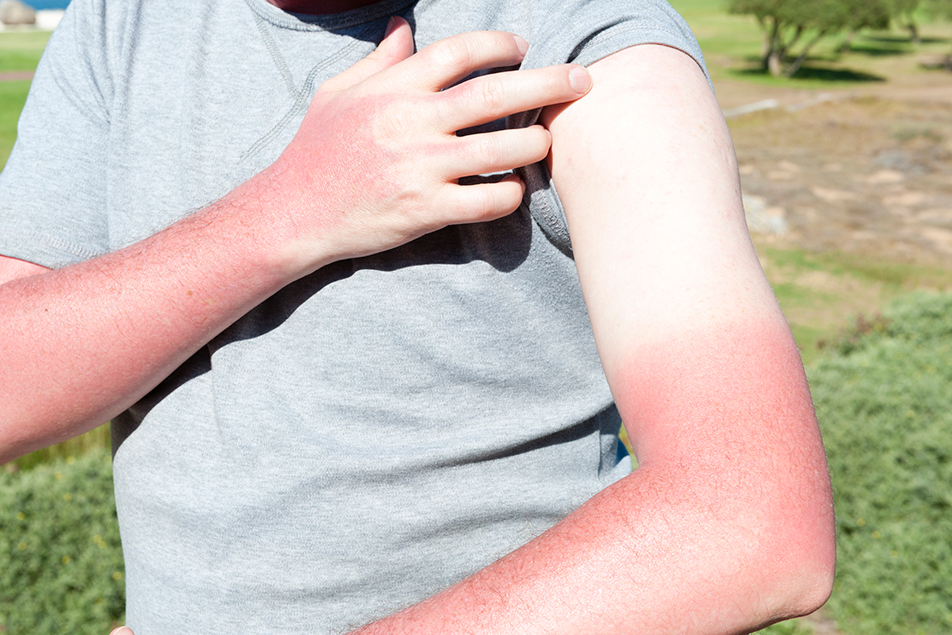
This post was written by Katherine Brown, PharmD, Parkview Health.
As we head into the summer months and the temperature warms up, our skin is more likely to be directly exposed to the heat of the sun. While spending time outside is a wonderful way to get physical activity and increase vitamin D, too much exposure can increase the risk of skin cancer. There are many ways to protect your skin from these risks while still being able to enjoy summer’s splendor.
How does the sun contribute to skin cancer risk?
The sun gives off ultraviolet light, often called UV rays. These rays are not visible, and also come from tanning beds and sunlamps. If your skin gets exposed to significant UV rays over your lifetime, it causes skin damage that leads to skin cancer.
Two specific kinds of UV rays contribute to cancer risk:
- Ultraviolet A (UVA), commonly associated with skin aging
- Ultraviolet B (UVB), often associated with skin burning
UV rays go through clouds, even in cool weather, and can reflect off water, cement, sand and snow. This means you are at risk even in the winter! In the United States, UV rays are usually strongest from 9 a.m. to 3 p.m. standard time.
How can I protect my skin from the sun?
There are multiple ways you can reduce your risk of skin cancer from exposure to UV rays:
- Optimize time in the shade, such as underneath trees or a shelter. Remember that clouds do not protect you from UV rays.
- Wear long-sleeved shirts and long pants. A dry shirt is better than wet and darker colors are better than lighter colors. Some clothing has special certification for UV protection.
- Wear wide-brimmed hats to protect parts of your head that we don’t often think about, such as ears and the back of your neck. A baseball cap will not protect these parts of your body, although it will provide shade to your eyes and face.
- Wear sunglasses to protect your eyes and the thin skin around your eyes.
- Sunscreen!
What kind of sunscreen should I use and how do I use it?
The FDA regulates sunscreen to meet certain standards for skin protection. Broad spectrum sunscreens will protect you from both UVA and UVB. Not all sunscreens are broad spectrum so be sure to check the label.
Sun Protection Factor (SPF) is a measure of how well the sunscreen will protect you. It compares how much sun radiation is needed to make a sunburn on protected skin compared to unprotected skin. The higher the number, the better the protection. An SPF of at least 15 will provide appropriate sun protection.
There are two types of ways sunscreen can protect you:
- Physical sunscreens have active mineral ingredients that sit on top of the skin and physically block UV rays. Sunscreens with titanium dioxide or zinc oxide are physical sunscreens. These options are less likely to irritate skin and are ideal for people with rosacea or other skin conditions.
- Chemical sunscreens have active ingredients that absorb UV rays upon contact. A chemical reaction occurs to prevent the harmful effects of UV rays. Sunscreens with avobenzone, octinoxate, octisalate, oxybenzone, or octobenzone are chemical sunscreens. These sunscreens are thinner and spread more easily onto skin but are more likely to irritate skin. You must also re-apply more frequently than physical sunscreens.
Apply sunscreen to all areas of the body that will be exposed to the sun. This includes ears, nose, lips, back of the neck, hands, tops of feet, along the hairline, and other areas of the head not covered by hair. Apply to skin 15 minutes before going outside. Reapply sunscreen every 2 hours or more often if you are swimming or sweating (don’t be fooled by “waterproof” or “water-resistant” sunscreen, as these can still wear off as soon as 40 minutes after application).
Sunscreen is not recommended for children younger than 6 months old. Please utilize other methods of skin protection.
How do I treat a sunburn?
Despite proper protective measures, it is still possible to get a sunburn, especially if you have fair skin. Follow these guidelines for treating a sunburn:
- Stop continued exposure to the sun—preferably stay inside until the sunburn heals.
- Short and cool baths or showers help relieve pain.
- Water-based moisturizers with aloe vera help soothe the skin. Aloe gels may also help.
- For particularly painful areas, hydrocortisone cream can be applied to the skin. This can be purchased without a prescription. Do not apply to open blisters.
- Over-the-counter anti-inflammatory medications such as ibuprofen or naproxen can help relieve pain and irritation. Ask your doctor or pharmacist if these medications are safe for you to take.
- Drink extra water to prevent dehydration from a sunburn.
- Allow blisters to heal if they occur. Do not pop blisters, as they help your skin heal and protect from infection.
- Avoid any medication ending in “caine” such as benzocaine. These may irritate your skin more.
When should I seek medical attention?
Some sunburns can be severe enough that they shouldn’t be treated at home. Seek additional help from an urgent care or the emergency room if any of the following occur:
- You develop severe blistering on a large portion of your body
- You develop a fever or chills
- You become dizzy or confused
Use your local pharmacist as a resource to decide whether you should seek additional medical care.
References
Skin Cancer: Sun Safety. Centers for Disease Control and Prevention
Sunscreen: How to Help Protect Your Skin from the Sun. Food and Drug Administration
UV Radiation & Your Skin. Skin Cancer Foundation
How to Treat Sunburn. American Academy of Dermatology



